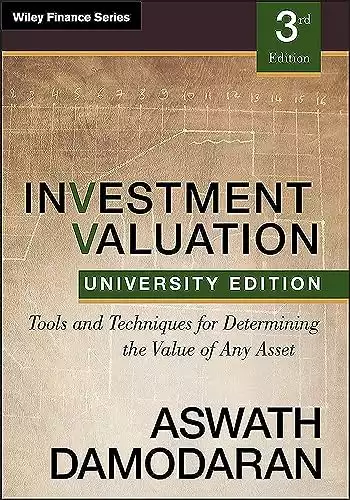Overview : Investment Valuation
- Book Title: Investment Valuation
- Author: Aswath Damodaran
- Publication Date: April 2012 (3rd Edition)
- price: $63.32
- Pages: 992
Overview of the Book
The author of Investment Valuation is Aswath Damodaran, a globally renowned finance professor and valuation expert. Known as the "Dean of Valuation," his books are celebrated for simplifying complex financial concepts for students and professionals alike.
Introduction
In the ever-evolving world of finance and investing, understanding the true value of assets is crucial for making informed decisions. Aswath Damodaran's "Investment Valuation: Tools and Techniques for Determining the Value of Any Asset" stands as a beacon of knowledge in this complex field. This comprehensive review explores the depth and breadth of Damodaran's work, its relevance in today's financial landscape, and its value to both novice and seasoned investors.
Book Summary
"Investment Valuation" is structured into three main parts, each building upon the last to create a holistic understanding of valuation techniques:
1. Foundations of Valuation
- Core principles of valuation
- Time value of money
- Risk assessment
- Cash flow analysis
2. Valuation Techniques
- Discounted Cash Flow (DCF) valuation
- Relative valuation using multiples
- Contingent claim valuation
3. Applications of Valuation
- Valuing businesses
- Equity valuation
- Real estate valuation
- Valuation in diverse investment environments
Analysis of Themes
Damodaran's work delves deep into the intricacies of valuation, addressing key themes that resonate with current market trends:
Risk and Uncertainty
In an era of volatile markets and economic uncertainties, Damodaran's emphasis on incorporating risk factors into valuation models is particularly relevant. His insights help investors navigate unpredictable financial landscapes, a skill crucial in today's fast-paced market environment.
Adapting to New Asset Classes
As the financial world expands to include cryptocurrencies and ESG investments, Damodaran's foundational principles provide a framework for adapting traditional valuation methods to these emerging asset classes. This adaptability makes the book a timeless resource in a rapidly changing financial ecosystem.
Practical Application
The book bridges the gap between theory and practice through extensive use of real-world examples and case studies. This approach is invaluable for readers looking to apply valuation techniques in actual investment scenarios, from personal finance decisions to professional investment strategies.
Writing Style
Damodaran's writing is characterized by its clarity and accessibility. He masterfully breaks down complex financial concepts into digestible segments, making the book approachable for readers with varying levels of financial expertise. The author's engaging style keeps readers invested throughout, turning what could be dry financial theory into an engaging learning experience.
"The essence of valuation is simplicity, and the most powerful insights come from simple models."
This quote exemplifies Damodaran's approach to demystifying valuation, encouraging readers to focus on fundamental principles rather than getting lost in overly complex models.
Strengths and Weaknesses
Strengths:
- Comprehensive coverage of valuation techniques
- Abundant real-world examples and case studies
- Critical analysis of each valuation method's limitations
- Adaptability to current market trends and new asset classes
Weaknesses:
- May be challenging for absolute beginners in finance
- Some sections require a foundation in accounting principles
- The depth of content may be overwhelming for casual investors
Comparison to Other Works
When compared to other valuation texts like "Valuation: Measuring and Managing the Value of Companies" by McKinsey & Company, Damodaran's work stands out for its broader scope and more accessible approach. While McKinsey's book focuses primarily on corporate valuation, "Investment Valuation" covers a wider range of assets and is more suitable for individual investors and finance students.
In contrast to Benjamin Graham's "The Intelligent Investor," which focuses on value investing principles, Damodaran's book provides a more technical and comprehensive look at the valuation process itself. This makes "Investment Valuation" an excellent companion to Graham's work for those looking to deepen their understanding of the mechanics behind value investing strategies.
Highlights from Investment Valuation
- Valuation techniques: Provides comprehensive methods for valuing different types of investments.
- Discounted cash flow (DCF): Emphasizes the importance of projecting future cash flows and discounting them.
- Market comparables: Discusses using market multiples to value companies relative to peers.
- Risk assessment: Highlights adjusting valuations for various risk factors.
- Real options: Explores the value of flexibility and strategic decision-making in investments.
- Asset pricing models: Reviews models like CAPM to understand risk-return tradeoffs in valuation.
Conclusion
Aswath Damodaran's "Investment Valuation" is an indispensable resource for anyone serious about mastering the art and science of valuation. Its comprehensive approach, practical insights, and adaptability to modern financial landscapes make it a must-read for finance professionals, students, and dedicated individual investors alike.
In a world where financial markets are increasingly complex and interconnected, the ability to accurately value assets is more crucial than ever. Whether you're navigating personal finance decisions, considering cryptocurrency investments, or analyzing market trends, the principles outlined in this book provide a solid foundation for making informed financial choices.
For those ready to elevate their understanding of investment valuation and enhance their financial decision-making skills, "Investment Valuation" is an invaluable addition to your financial library.





